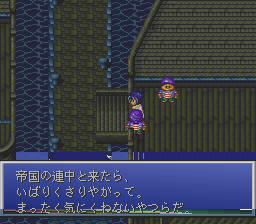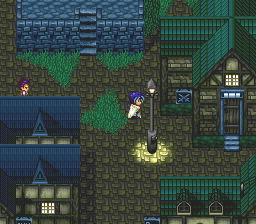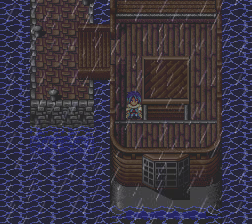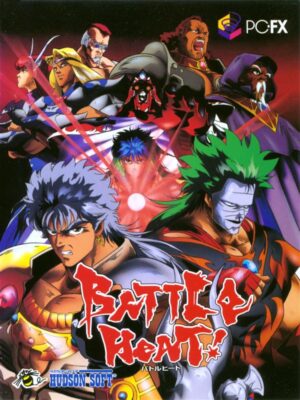Retro Replay Review
Gameplay
Miraculum: The Last Revelation embraces the classic hallmarks of a Japanese-style RPG, offering a sprawling world map dotted with towns, hidden dungeons, and treacherous wilderness. Exploration feels rewarding, as each region holds unique treasures, optional side quests, and secret passages that beckon you to stray from the main path. Whether you’re navigating coastal ports or delving into demon-infested ruins, the sense of discovery keeps the journey fresh for dozens of hours.
(HEY YOU!! We hope you enjoy! We try not to run ads. So basically, this is a very expensive hobby running this site. Please consider joining us for updates, forums, and more. Network w/ us to make some cash or friends while retro gaming, and you can win some free retro games for posting. Okay, carry on 👍)
Combat unfolds in traditional turn-based encounters, but it’s anything but stale. Each party member boasts a distinct moveset—ranging from Jay’s agile swordwork to a mage’s devastating elemental spells—and the introduction of sci-fi-inspired abilities adds an unexpected twist. Battles demand both strategy and adaptability: you can micromanage every action or let the AI take over by assigning general tactics. This flexibility caters to both veterans who savor every tactical nuance and newcomers who prefer a more streamlined experience.
Character progression strikes a satisfying balance between depth and accessibility. As you recruit allies, you’ll customize their skill trees, equipping gear that reflects each hero’s strengths. Dungeons often culminate in boss fights that test your party’s cohesion, while optional mini-bosses reward careful preparation. Coupled with a quick but flavorful text system and the occasional puzzle, the gameplay loop remains engaging from the first port town to the final confrontation.
Beyond battles and exploration, Miraculum adds layers of immersion through crafting and resource management. Scavenging components from defeated enemies and ancient relics lets you forge new weapons or enhance armor. This mechanic encourages revisiting earlier areas with fresh gear, opening up alternative strategies for tackling previously insurmountable foes. The result is a gameplay experience that feels both nostalgia-driven and refreshingly modern.
Graphics
Visually, Miraculum channels the golden age of 16-bit JRPGs, delivering richly colored sprites and intricately detailed backdrops. Towns are teeming with pixel-art life—bustling marketplaces, winding alleyways, and ornate castle courtyards feel vibrant and lived-in. Each environment conveys its own mood, from the eerie glow of demon-haunted crypts to the sterile corridors of futuristic research labs.
The game’s standout feature is its anime-style cinematic sequences. Fully voiced key conversations and animated cutscenes elevate pivotal story moments, lending cinematic flair uncommon in games of this era. Voice-overs are crisp and professional, bringing emotional weight to character interactions and heightening the tension whenever the demon-possessed Siegwald makes an appearance. These segments seamlessly bridge exploration and narrative, making every chapter transition feel like an event.
On the technical side, the CD-quality soundtrack shines through, featuring sweeping orchestral themes and atmospheric tracks that accentuate both the grandeur of epic battles and the quieter moments of exploration. Sound effects—metal clashing, spellcasting hums, and ambient echoes—immerse you further into Miraculum’s dual medieval-sci-fi universe. Even years later, the combination of pixel art and high-fidelity audio creates a strikingly cohesive aesthetic.
While the visual style pays homage to 16-bit classics, there are moments when sprite flicker or screen transitions feel a bit dated. However, these minor drawbacks rarely detract from the overall charm. In fact, nostalgia-seekers will appreciate the retro fidelity, while newcomers will find the presentation charming and instantly recognizable.
Story
At its core, Miraculum tells a grand tale of power, corruption, and redemption. The narrative kicks off with King Siegwald’s ill-fated quest to harness demonic forces—a gamble that goes horribly wrong, as the ancient demon consumes his soul and crowns itself Emperor of a sprawling empire. This dark premise sets a foreboding tone, and the game wastes no time immersing you in Siegwald’s twisted reign of terror.
Enter Jay, a stoic warrior drawn to the port city of Heles by whispers of the emperor’s atrocities. From the moment Jay sets foot on familiar cobblestones, the stakes are clear: gather loyal allies, unearth the demon’s vulnerabilities, and mount a rebellion against impossible odds. Along the way, you’ll forge bonds with a cast of compelling characters—each with their own scars, motivations, and personal quests. These individual backstories enrich the main plot, balancing political intrigue with heartfelt moments of camaraderie.
Story pacing is one of Miraculum’s strongest suits. Early chapters focus on world-building and character recruitment, gradually escalating to epic showdowns and shocking revelations about the demon’s true agenda. Twists abound, from betrayals within the ranks to the discovery of ancient technologies left behind by a lost civilization. The blend of medieval fantasy with sci-fi elements deepens the lore, ensuring each narrative beat feels fresh and unpredictable.
Dialogue is well-crafted, blending humor, drama, and philosophical musings on the nature of power and humanity. The game’s writing often shines in quieter moments—around campfires or while exploring haunted ruins—where characters reflect on their pasts and the sacrifices demanded by war. These quieter beats complement the grand scope of the story, making the climax feel both momentous and personally resonant.
Overall Experience
Miraculum: The Last Revelation is a love letter to fans of classic JRPGs, yet it manages to carve out its own identity through bold narrative choices and quality-of-life innovations. The fusion of medieval fantasy tropes with sci-fi touches makes for an intriguing setting, and the game’s length—clocking in at 40 to 60 hours for completionists—provides substantial value. Whether you’re chasing optional dungeons or savoring every cutscene, there’s plenty to see and do.
Replayability is strong, thanks to branching side quests, optional boss encounters, and multiple difficulty settings. The ability to adjust character AI strategies on the fly encourages experimentation with party compositions, keeping subsequent playthroughs dynamic. Add to that a robust crafting system and hidden post-game content, and you’ve got a title that invites return visits long after the credits roll.
While some modern players might find the random battle frequency a touch high, and certain puzzles occasionally cryptic, these minor hurdles pale in comparison to the game’s many strengths. From its compelling story to its memorable cast and evocative presentation, Miraculum delivers a satisfying, well-rounded experience that honors the traditions of its genre while staking its own claim.
For anyone yearning for a nostalgic journey with enough modern touches to avoid feeling stale, Miraculum: The Last Revelation is a must-play. It stands as proof that classic design philosophies, when executed with care and creativity, can still captivate audiences—and perhaps inspire a new generation to fall in love with the timeless magic of JRPGs.
 Retro Replay Retro Replay gaming reviews, news, emulation, geek stuff and more!
Retro Replay Retro Replay gaming reviews, news, emulation, geek stuff and more!









Reviews
There are no reviews yet.